Passionfruit sponge cake, made from scratch. Fluffy and feather-light sponge cakes are sandwiched with clouds of whipped cream and topped with tangy passion fruit icing. Tall, light and airy, this luscious sponge cake is easy to whip up for afternoon tea or a special celebration.
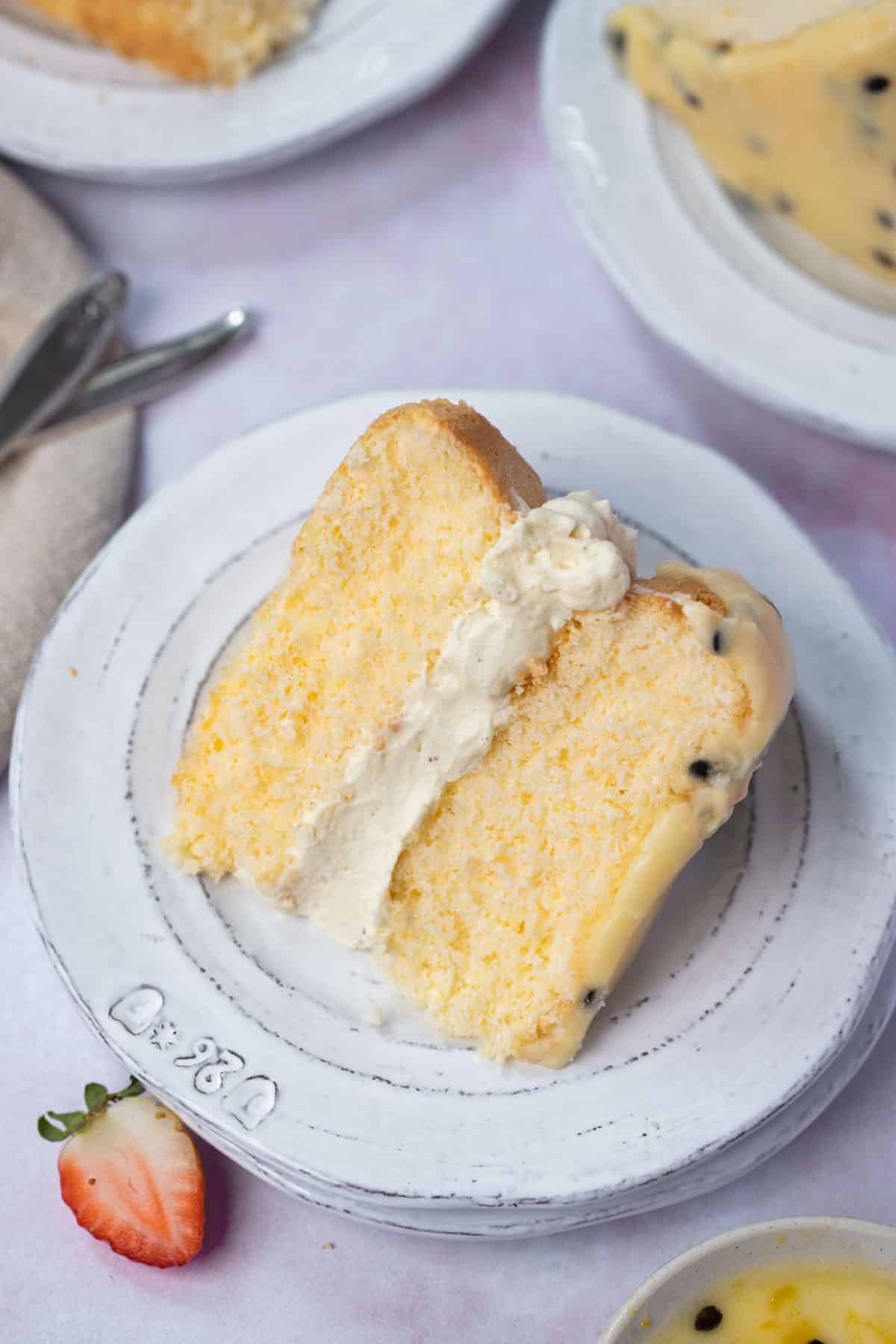
This is a long post, full of helpful tips and step-by-step photos to achieve the perfect sponge cake, every time. Sponge cakes are delicate and can be prone to sinking, and some people find them intimidating or need help troubleshooting common issues. To skip these tips and head straight to the recipe, hit the ‘jump to recipe’ button at the top of the post.
Why you’ll love this recipe
- Step by step guide – sponge cakes can be tricky to perfect, but these tips and tricks make it easier to get a beautifully light and tender sponge, every time.
- Simple ingredients – this recipe uses a handful of basic pantry staples like cornflour, eggs and custard powder and requires minimal preparation.
- Perfect for any occasion – serve it for morning or afternoon tea, high tea, family celebrations or special occasions.
- Weights – the ingredients (including the eggs) are weighed in this recipe, giving you the same results each time.
- Customisable – the sponge itself is not overly sweet and is the perfect base for your favourite fillings. While passion fruit icing and whipped cream are a retro favourite, you can also add lemon curd, raspberry jam and cream, strawberries and cream, a dusting of icing sugar or whatever you fancy!
- Old-fashioned recipe – an Australian classic, this is an old family recipe that has been tried, tested and much-loved for decades.
Ingredients you will need
** This post contains tips and instructions to achieve the best possible results. The photo above is a great guide for when you are in the supermarket, but for full ingredient quantities and methods, please scroll down to the detailed recipe card below!
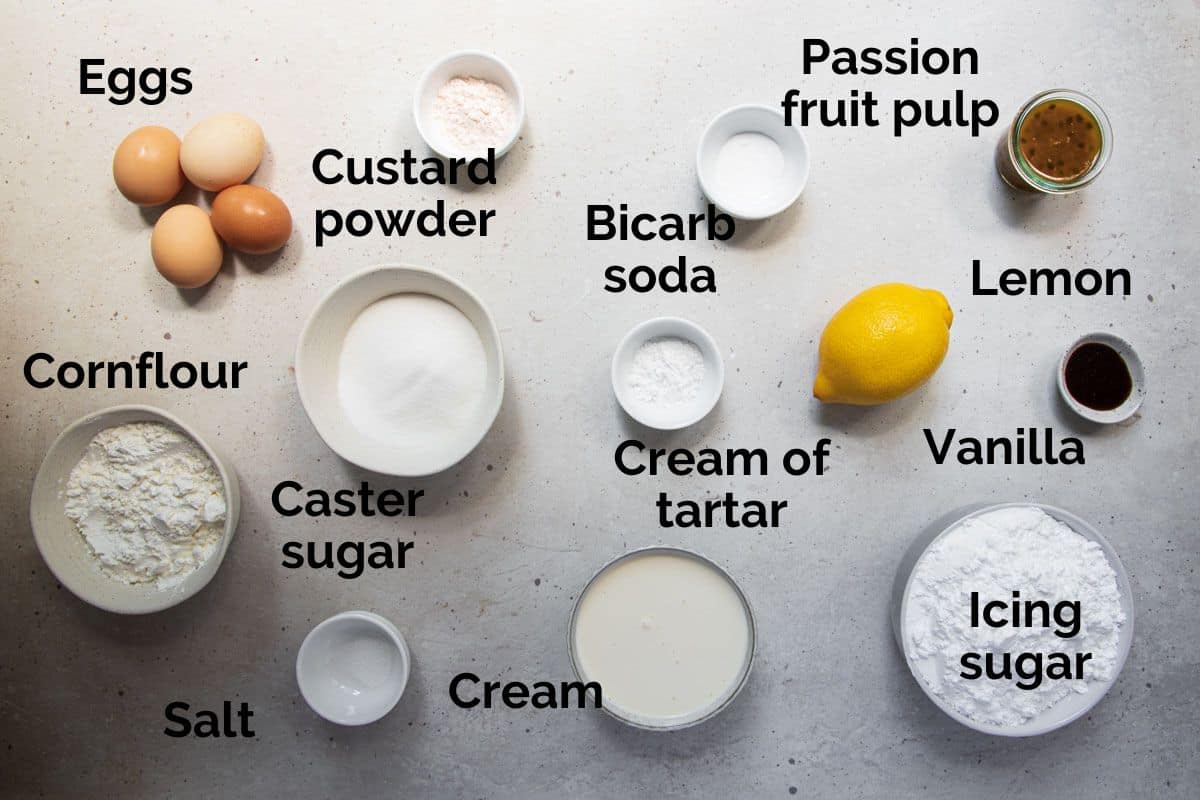
- Eggs – the structure of the sponge cake comes from whipping air into the egg whites, before gently adding the other ingredients. For this recipe, you will need 4 large eggs, separated and at room temperature. Room temperature egg whites beat more easily than cold eggs and allow more air to enter the mixture. Weights are included, for accuracy.
- Caster sugar – also called superfine sugar, caster sugar is recommended for this recipe because it dissolves into the egg whites more easily than granulated sugar. Add the sugar gradually, to ensure the mixture doesn’t become gritty.
- Cornflour – also called corn starch, cornflour is a fine, white starch powder that is commonly used in light baking. It gives the cake structure and stability, while maintaining a tender and light crumb. Wheaten cornflour or regular cornflour can be used. But please note that wheaten cornflour is made out of wheat, instead of maize. The texture and taste of both are similar, but the biggest difference is that regular cornflour is gluten-free, where wheaten cornflour is not. Use regular cornflour if you require the cake to be gluten free.
- Custard powder – a thick, cornflour-based powder which thickens into custard when mixed with milk and heated. For this recipe, it provides structure, stability and a light vanilla flavour. Choose a gluten-free custard powder, if needed. You can even make your own!
- Baking soda – also called sodium bicarbonate or “bicarb soda” in Australia, baking soda reacts with the cream of tartar (acid) to produce air bubbles and help the cake rise. Check the expiry on the packet and make sure it is in-date, or it won’t be effective.
- Cream of tartar – an acid that stabilises the whipped egg whites and helps to prevent collapse. Cream of tartar is found in the baking aisle in supermarkets.
- Heavy cream – for the whipped cream, use heavy whipping cream or thickened cream with a fat content over 35% to ensure that the cream will whip into soft peaks. Keep it cold at all times.
- Passion fruit – use fresh passion fruits when they are in season and scoop out the pulp. When passion fruit are not readily available, use frozen/fresh passion fruit pulp with no additives, added sugar or flavours. Canned pulp can also be used, but fresh or frozen has the best flavour.
- Icing sugar – you’ll need icing sugar (powdered sugar/confectioner’s sugar) for both the passion fruit icing and as a sweetener for the whipped cream.

Step by step instructions
Full ingredient notes and quantities can be found in the detailed recipe card below. But here is a brief overview of what you can expect;
Step 1 – Prep;
Prepare 2 x 20 cm springform cake tins by lining the bottom (not the sides) with baking paper. Grease the sides of the tin with a little butter or oil spray and then dust the sides of the tins with flour. The flour will stick to the butter, which will help the sponge cake to rise. Tap the excess flour from the tin. (Image 1).
Sift the cornflour, custard powder and bicarb soda three times and set aside. (Image 2).


Step 2 – Beat the egg whites;
Beat the egg whites on low-medium speed until the mixture becomes white, foamy and forms soft peaks. Room temperature egg whites will beat more easily and will hold more air than cold egg whites.

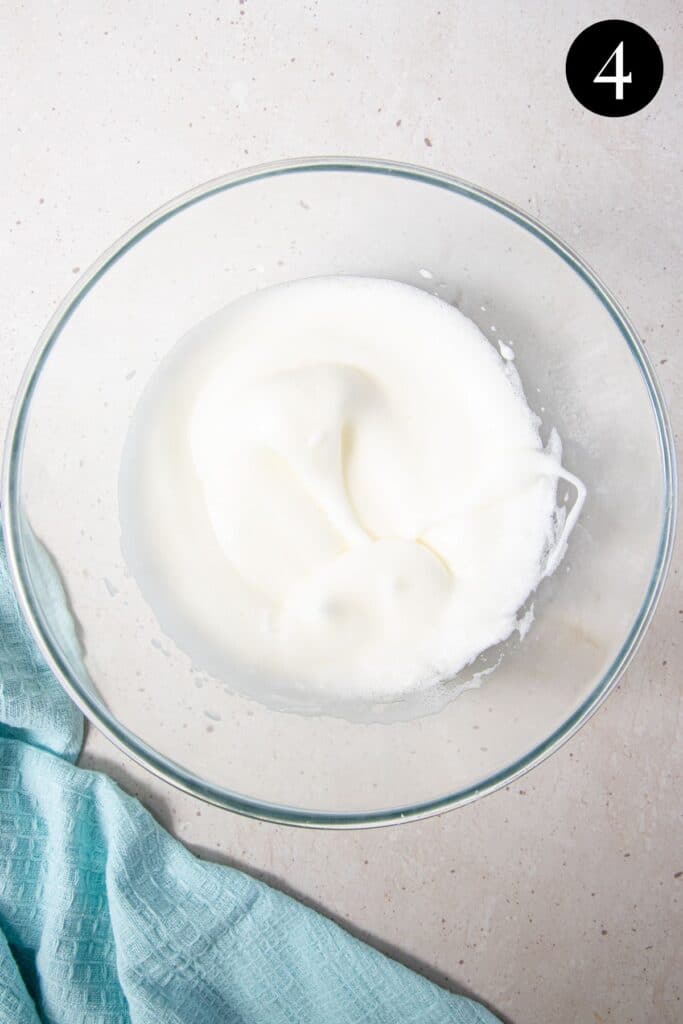
Step 3 – Add the sugar;
While beating, gradually add the caster sugar, one tablespoon at a time. Turn the speed up to medium and beat only until the sugar has dissolved (the mixture should feel smooth and not gritty) and the mixture is thick and glossy, with stiff peaks.
Beat in the cream of tartar.
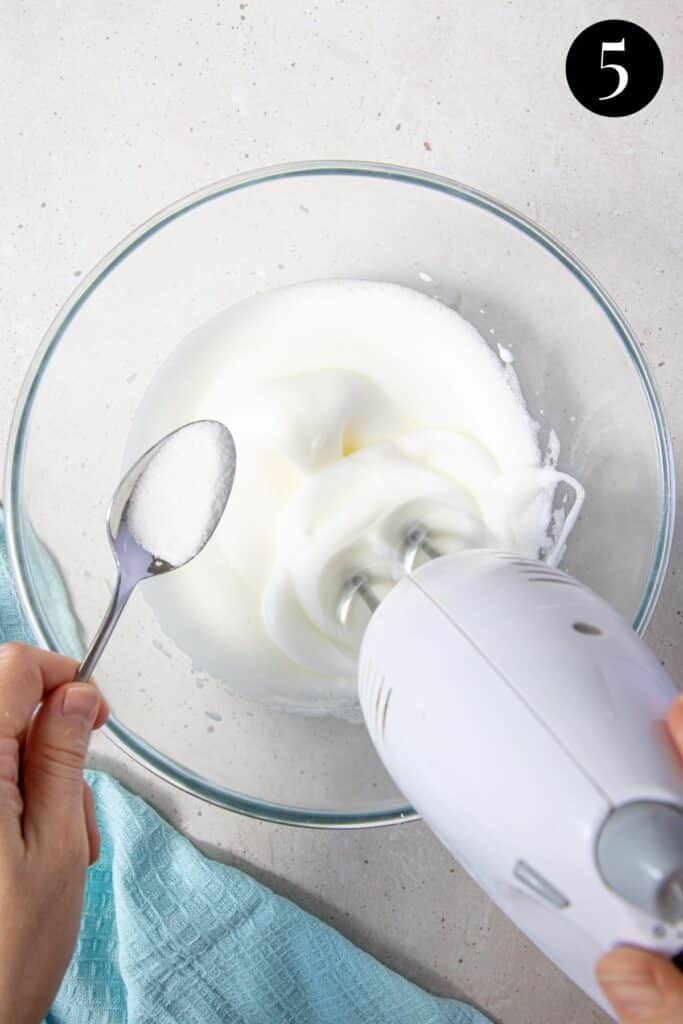
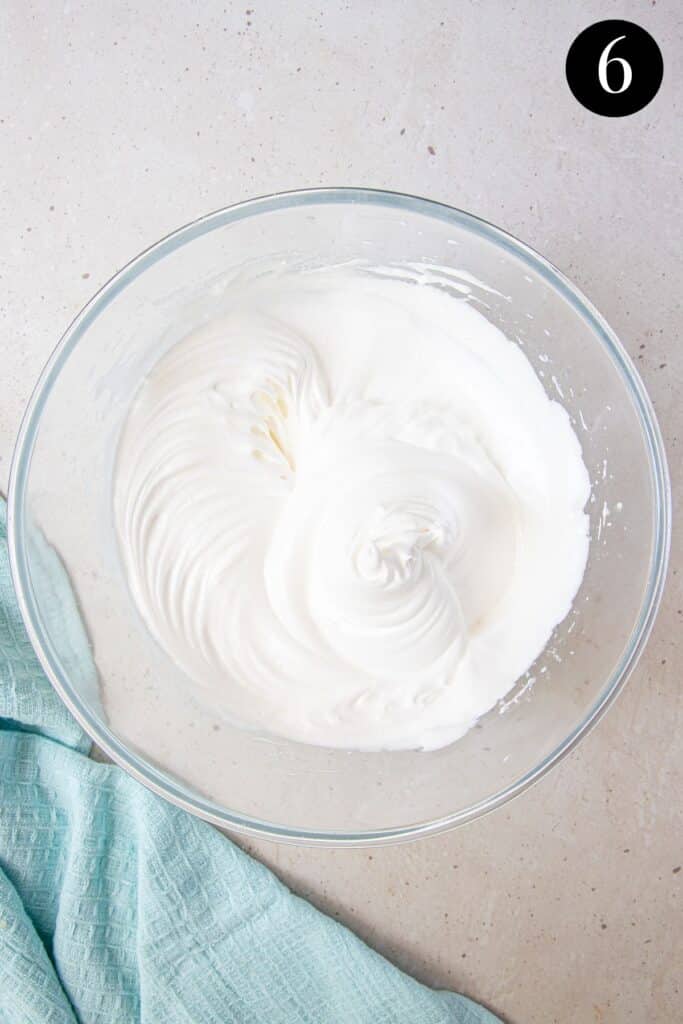
Step 4 – Fold;
Using a spatula or a large metal spoon, gently fold in the beaten egg yolks.

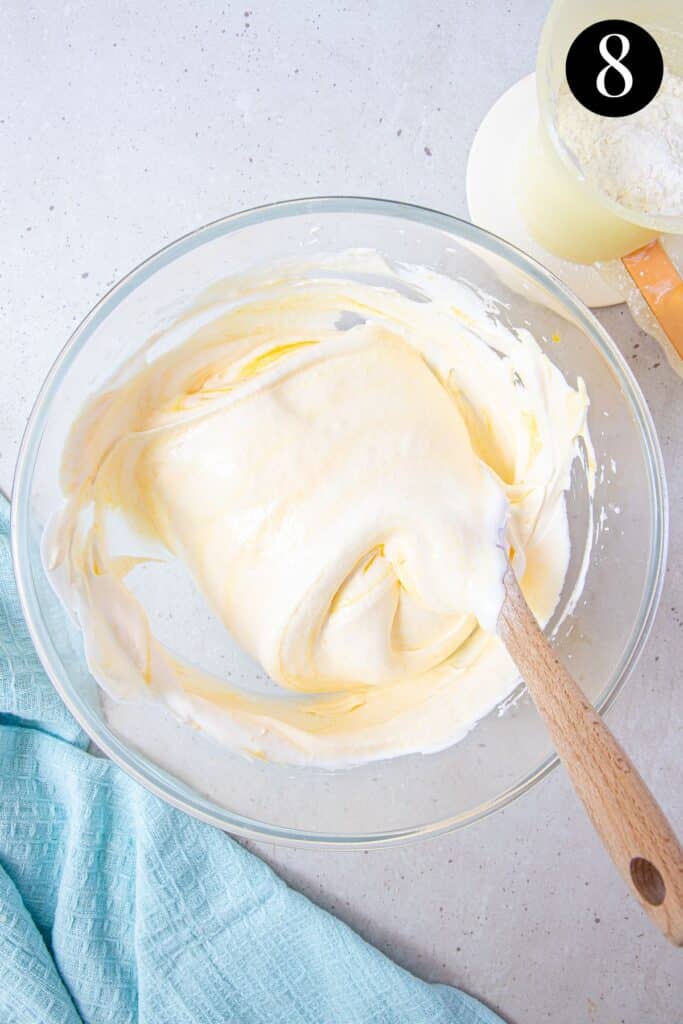
Sift a third of the cornflour mixture over the top and gently fold it into the egg mixture. Continue adding the cornflour mixture in thirds, folding in between additions, until the cornflour mixture is incorporated. Fold as minimally as possible; don’t overmix.
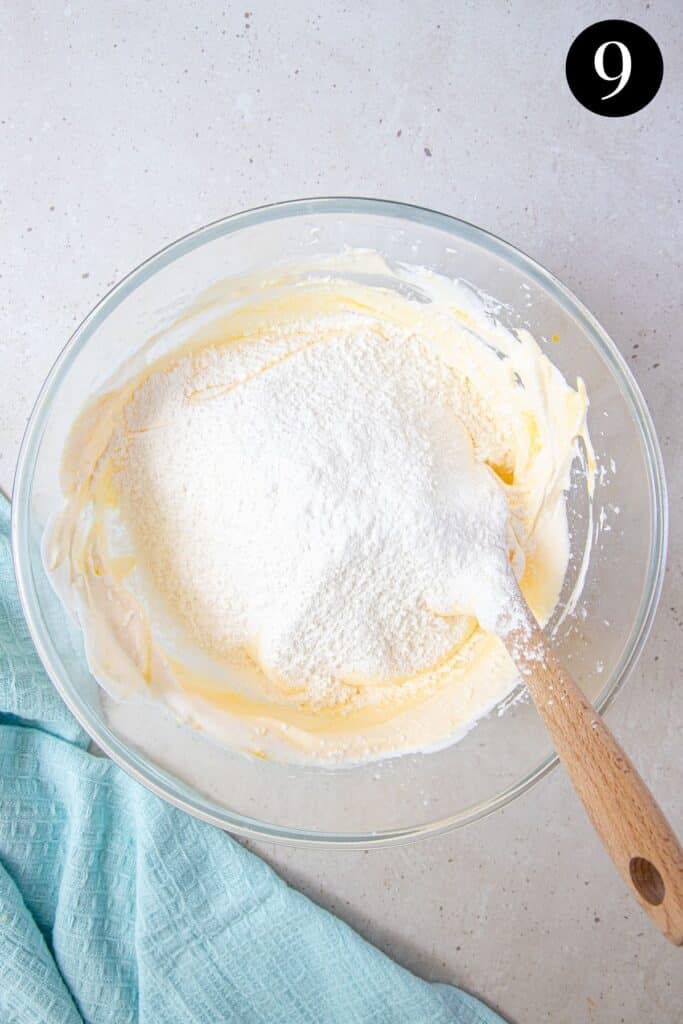
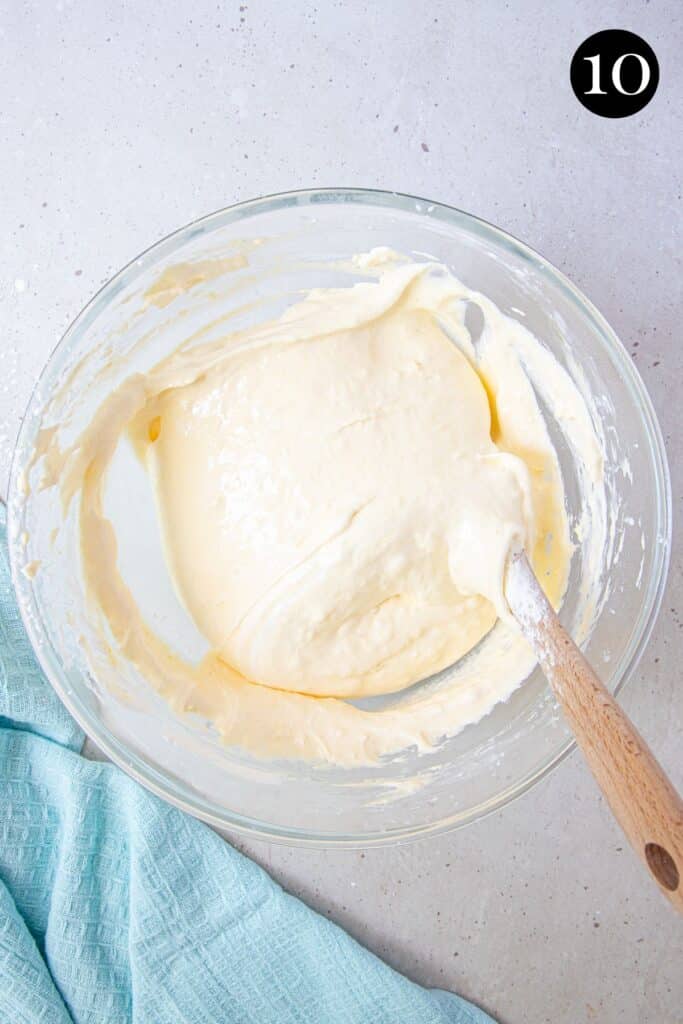
Step 5 – Bake;
Divide the sponge cake batter evenly between the cake tins (baking scales can be handy to divide evenly) and bake for around 16-18 minutes, until the cakes are lightly golden and spring back if gently pressed in the middle. The cake will also start to pull away from the sides of the tin.
Leave the cakes in the tins for 5 minutes before gently turning onto a wire rack to cool. A towel can be placed underneath to stop the wire pressing into the cake.


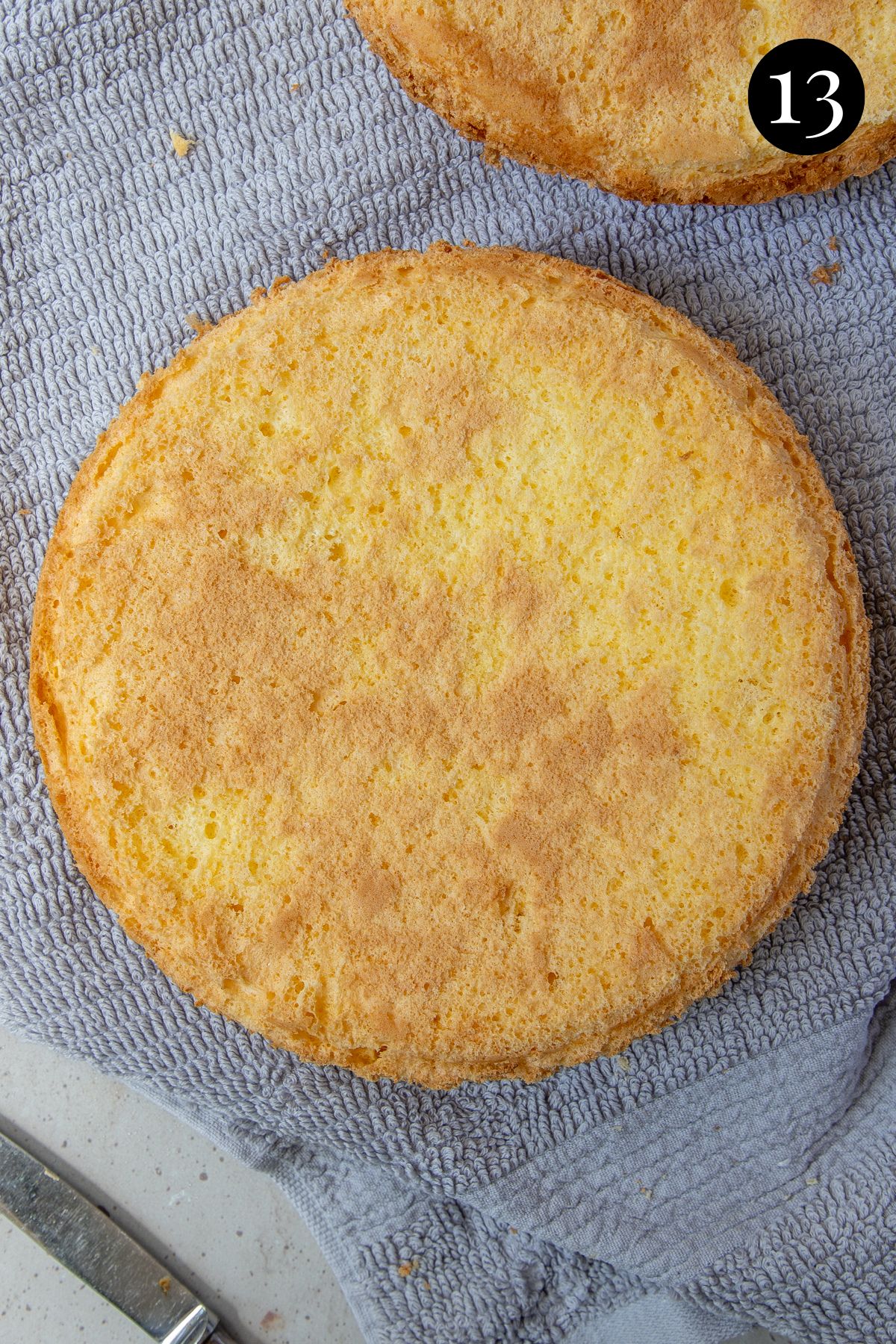
Step 6 – Make the whipped cream;
Beat the cream, vanilla and icing sugar to soft peaks.

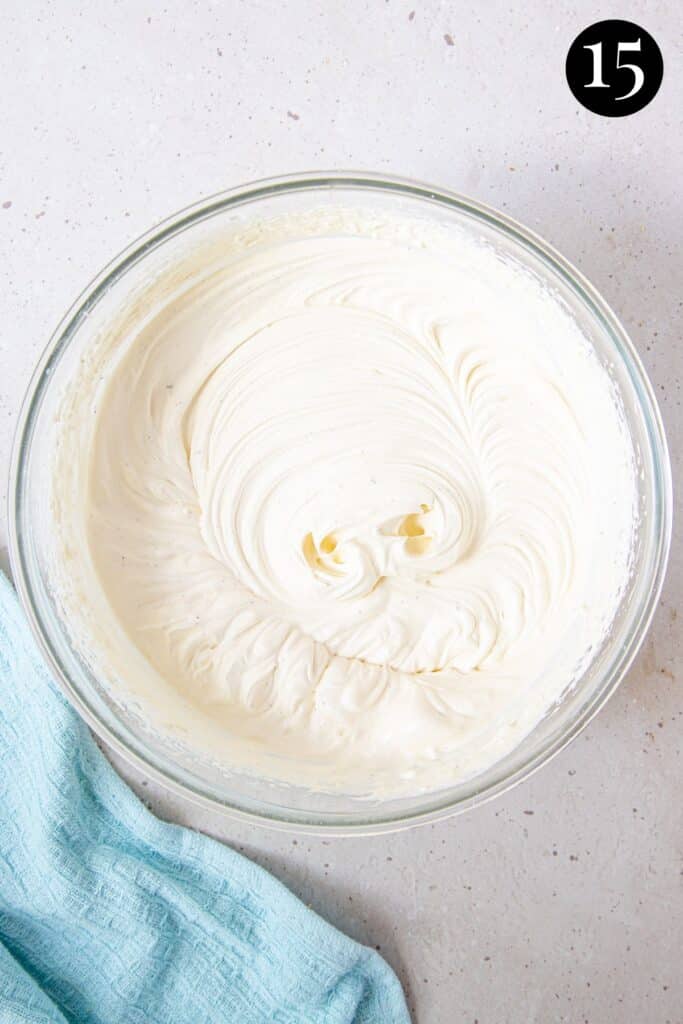
Step 7 – Make the passion fruit icing;
Mix the icing sugar with enough passion fruit pulp and lemon juice to make a firm, but spreadable icing.
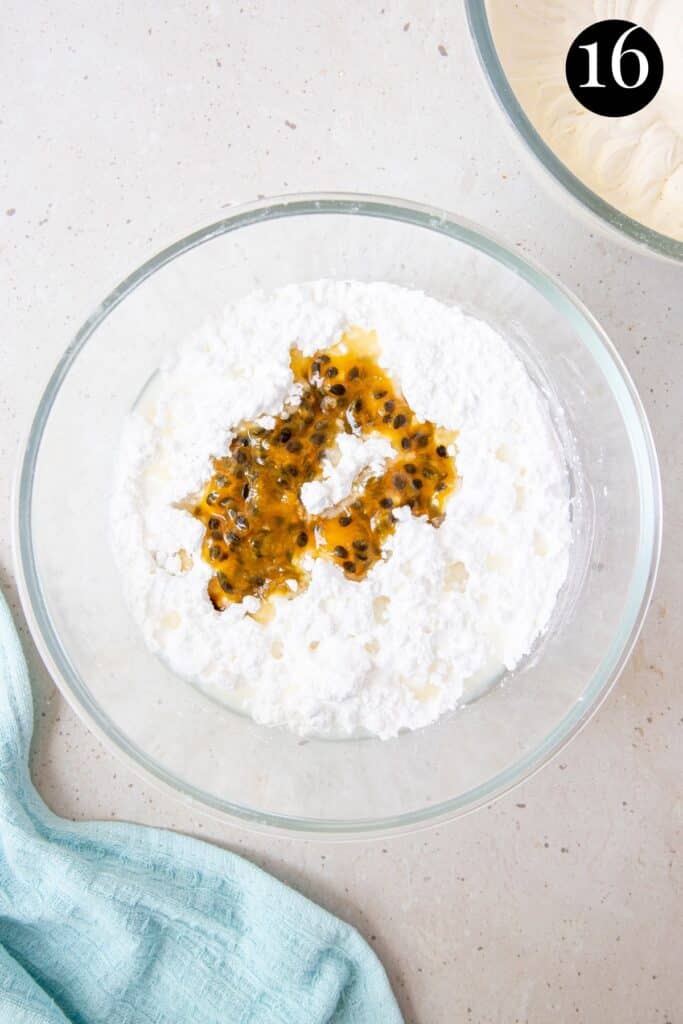

Assemble the cake by spooning the whipped cream onto one of the cakes. Top with the remaining cake and cover with the passion fruit icing.
Expert tips
- Use fresh, room temperature eggs. Room temperature eggs will whip more easily than cold eggs and achieve more volume. Separate the eggs and let them reach room temperature before baking.
- Make sure there is no yolk in your egg whites! Yolk contains fat and even small amounts can interfere with how the egg whites foam up.
- Sift the flour three times and add it to the batter in stages. Sifting removes lumps and results in a lighter batter.
- Don’t overbeat the egg whites. Whisk until the meringue is glossy and thick, with firm peaks and the sugar has dissolved. If it is grainy and dull, it has been overbeaten.
- Gently fold the flour into the egg whites with a spatula or large metal spoon. Do this gently, to keep the air in the mixture. If you are too heavy-handed, the mixture will become runny and your sponge won’t rise. Fold from the bottom of the bowl, lifting and folding the batter over itself only until everything is combined. Don’t overmix.
- Don’t over-grease the tins. The batter sticking to the sides actually helps the sponge “climb” and hold its shape as it cooks. Line only the bottom of the tins with baking paper and leave the sides bare, with a little oil spray that is coated in flour. Tap out any excess flour before adding the cake batter. The flour helps the cake to hold on to the sides as it rises.
- To ensure the cakes cook evenly, place both cake tins in the middle rack on the same shelf and try to divide the cake batter as evenly as possible.
- This recipe uses two cake tins, to make two sponges that are stacked with cream and icing. You can also bake in one large cake tin, or one ring tin. Baking times will vary (approximately 40 minutes for one tin or 28-30 minutes for a 23cm ring tin).
- Accurately measure and weigh your ingredients. Use a baking scale, for best results. Any change in ingredient quantities can alter the outcome of the sponge.
- Watch the bake time. Baking times can vary, depending on the type of cake tin and the oven that you use. If the sponge is under-baked, it will sink in the middle. And over-baking the sponge will make it dry. Remove the cake from the oven when it is lightly golden all over and springs back if lightly pressed in the middle.
- Don’t open the oven door during the baking process. A sudden temperature change can make the sponge collapse.
- Allow the sponge to cool completely before assembling. Otherwise, the cream and icing will melt.
FAQs
Because sponge cakes rely on air being whipped into the eggs, they are quite delicate and can be more prone to sinking than other cakes. If your sponge is flat and rubbery or didn’t rise, the batter was most likely overmixed when adding the flour. Overmixing pushes the air out of the eggs which will cause them to deflate. A flat sponge can also be caused by a sudden change in temperature while baking. Keep the oven door closed until the cake is ready.
It also helps to flour the sides of the cake tins, which helps the cake ‘climb’ by holding onto the tin as it rises.
Also, check your leavening agents to make sure they have not expired, and measure all ingredients accurately for best results.
If the sponge sinks in the middle, it is usually because it has not quite fully baked. When ready, the sponges should be risen, firm in the middle if gently pressed and starting to pull away from the sides of the tin. If you need to open the door to check the cakes, wait until close to the end of the baking time. A sudden change in temperature can also cause the cake to sink if it has not quite cooked.
Sinking can also be caused by too much raising agent (in this case, baking soda). Be sure to measure the baking soda accurately and use level measures.
Sponge cake is dry if it has been overbaked. This may be from leaving it in the oven for slightly too long, or that your oven temperature is inaccurate (you can check this with an oven thermometer).
Un-decorated sponge cakes will keep in the freezer for up to 3 months. Be sure to wrap them well and keep them in an airtight container. Thaw at room temperature when ready to eat.
While sponge cake is best eaten fresh in the first 1-3 days, an un-decorated sponge cake can be kept for up to 5 days at room temperature. It needs to be covered with clingfilm or stored in an airtight container to prevent it from drying out. If you have decorated the cake with cream and icing, it needs to be kept in the fridge and will last for around 3-4 days.

Related recipes
Tried this recipe? Please leave a star ⭐⭐⭐⭐⭐ rating or leave a review below and let me know how you went!
Hungry for more? Subscribe to my newsletter and follow along on Facebook, Instagram and Pinterest for the latest recipes and news.

Passion Fruit Sponge Cake
Ingredients
- 4-5 large eggs at room temperature, separated. Egg whites should weigh 150 grams and yolks 70 grams.
- 1 tablespoon custard powder 9 grams
- 1 cup cornflour add the custard powder to a 250ml cup and then fill the rest of the cup with cornflour (125 grams)
- ½ teaspoon bi carb soda 3 grams
- pinch salt
- ¾ cup caster sugar 160 grams
- 1 teaspoon cream of tartar 5 grams
For the whipped cream
- 400 ml cream thickened, whipping cream
- 1 teaspoon vanilla bean paste or vanilla extract
- 1 tablespoon icing sugar
For the passion fruit icing
- ¼ cup fresh passion fruit pulp approx. 3-4 fresh passion fruit. Use fresh, or frozen pulp where possible.
- lemon juice freshly squeezed
- 3 cups icing sugar
Instructions
- Separate the eggs, placing the whites into one bowl and the yolks in another. Lightly beat the egg yolks. Cover the egg whites and yolks and set them aside to come to room temperature. Make sure there are no traces of egg yolk in the egg whites.
- Pre-heat oven to 170°C/338F fan-forced (recommended) (190°C conventional). Line 2 x 20 cm springform cake tins with baking paper on the bottom (not the sides). Lightly grease the sides of the tin with butter or oil spray. Dust the greased sides with a little flour and shake the excess flour from the tins.
- Place one tablespoon (9 grams) of custard powder into a 250ml measuring cup. Fill the rest of the cup with cornflour (125 grams).
- Sift the cornflour, custard powder and bicarb soda together three times and set aside.
- Place the egg whites and a pinch of salt together in a clean bowl or stand mixer and beat on low-medium speed, until the mixture is white, foamy and forms soft peaks.
- While continuing to beat the egg whites, gradually add the sugar (1 tablespoon at a time) until combined. Turn the speed up to medium and beat for around 5 minutes, until the sugar has dissolved and the mixture is thick, glossy and forms stiff peaks. Beat in the cream of tartar.
- Using a spatula or large metal spoon, fold in the beaten egg yolks, a little at a time, being careful not to over-mix.
- Sift one third of the cornflour mixture over the top of the egg whites and fold until combined. Continue to add the cornflour mixture in thirds, folding between additions, until combined.
- Gently divide the mixture into the prepared cake tins and bake for 16-18 minutes, or until cooked. Carefully test the sponges by gently pressing on the top. They will be lightly golden and spring back when ready.
- Remove the cakes from the oven and allow them to sit in the tins for five minutes before turning out onto a wire rack to cool completely. You can cover with a clean, dry towel to prevent the sponges from drying out.
For the cream
- Beat the cream, vanilla and icing sugar together with an electric or hand held mixer until the cream forms soft but firm peaks. Be careful not to overbeat.
For the passion fruit icing
- Combine the passion fruit pulp and icing sugar in a mixing bowl with enough lemon juice to make a firm but spreadable icing and stir to combine. If it is too runny, add a little more icing sugar.
To decorate
- When the cakes are cool, top one cake with whipped cream, then place the remaining sponge layer on top and cover with passion fruit icing. Place in an airtight container in the fridge to firm up slightly before slicing.
Notes
- Use fresh, room temperature eggs. Room temperature eggs will whip more easily than cold eggs and achieve more volume. Separate the eggs and let them reach room temperature before baking.
- Make sure there is no yolk in your egg whites! Yolk contains fat and even small amounts can interfere with how the egg whites foam up.
- Sift the flour three times and add it to the batter in stages. Sifting removes lumps and results in a lighter batter.
- Don’t overbeat the egg whites. Whisk until the meringue is glossy and thick with firm peaks. If it is grainy and dull, it has been overbeaten.
- Gently fold the flour into the egg whites with a spatula or large metal spoon. Do this gently, to keep the air in the mixture. If you are too heavy-handed, the mixture will become runny and your sponge won’t rise. Fold from the bottom of the bowl, lifting and folding the batter over itself only until everything is combined. Don’t overmix.
- Don’t over-grease the tins. The batter sticking to the sides actually helps the sponge hold its shape as it cooks. Line only the bottom of the tins with baking paper and leave the sides bare, with a little oil spray that is coated in flour. Tap out any excess flour before adding the cake batter. The flour helps the cake to ‘hold on’ to the sides as it rises.
- Temperatures for both fan-forced and conventional are listed in the recipe card, but I recommend cooking with a fan-forced oven where possible. Fan-forced ovens are good for baking sponges, as the fan helps to lift the sponge and give it more volume.
- To ensure the cakes cook evenly, place both cake tins in the middle rack on the same shelf.
- This recipe uses two cake tins to make two sponges that are stacked with cream and icing. You can also bake in one large cake tin, or one ring tin. Baking times will vary (approximately 40 minutes for one tin or 28-30 minutes for a 23cm ring tin).
- Accurately measure and weigh your ingredients. Use a baking scale, for best results.
- Watch the bake time. Baking times can vary, depending on the type of cake tin and the oven that you use. Ovens can vary vastly in temperature and this can affect the cooking time. If the sponge is under-baked, it will sink in the middle. And over-baking the sponge will make it dry. Remove the cake from the oven when it is lightly golden all over and springs back if lightly pressed in the middle.
- Don’t open the oven door during the baking process. A sudden temperature change can make the sponge collapse.
- Allow the sponge to cool completely before assembling. Otherwise, the cream and icing will melt.
- Freezing; Un-decorated sponge cakes will keep in the freezer for up to 3 months. Be sure to wrap them well and keep them in an airtight container. Thaw at room temperature when ready to eat.
- Storage; While sponge cake is best eaten fresh in the first 1-3 days, an un-decorated sponge cake can be kept for up to 5 days at room temperature. It needs to be covered with clingfilm or stored in an airtight container to prevent it from drying out. If you have decorated the cake with cream and icing, it needs to be kept in the fridge and will last for around 3-4 days.
- Please note that the nutrition information is based on the cake being divided into 8 slices, with one slice being one serve. The nutritional information is an estimate only and does not take into account any additional toppings or sides served with the cake.
- This recipe is made using Australian cups and spoon measurements. Any reference to cups or spoons in this recipe is in Australian metric. Due to cup sizes varying from country to country, I advise adjusting if necessary.
Nutrition
Are you following us on Facebook, Instagram and Pinterest?
Update Notes: This recipe was originally published in March 2019, but was re-published with new information and photos in May 2023.



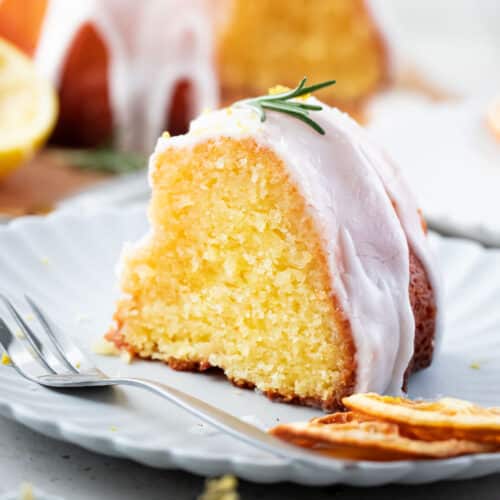


Meloney says
Could this be bakes in muffin tins?
Andrea Geddes says
Hi Meloney! I have never made this recipe into cupcake/muffins before, but you could definitely give it a try! It may take a little trial to work out how high to fill them and to work out the cooking time, but it should work fine!
Sylvie says
It looks so light and fluffy! This cake would be absolutely perfect for afternoon tea or a party!
Andrea Geddes says
Hi Sylvie! Thanks so much! It is one of my favourites and is absolutely perfect for afternoon tea 🙂
Rosa says
what brand of cornflour did you use ? I used to use cornflour in the orange box, successfully which was actually wheaten cornflour. that was discontinued and now I have different results using the cornflour which is now on the shelves
Andrea Geddes says
Hi Rosa! Thanks for your question. I have used both wheaten cornflour (which is made from wheat instead of maize) and regular cornflour for this cake and had similar, if not the same results for both. Generally they have a similar taste and texture in the final product, but it is interesting that you have noticed a difference. If you are browsing from Australia, I just checked and Coles have a ‘Royal Fields’ brand wheaten cornflour that might suit. I am going to test both and add some extra notes to this post. Thanks for your comment, I’m sure it will help others who try this recipe! Andrea. **Edited this comment to add – I just purchased the Kream brand wheaten corn flour from IGA and there was also another brand called Fielders on the shelf too which was also wheaten. I hope that helps! Andrea.
Maggie says
Made the cake but I think it would have turned out better if it was baked in a couple of smaller tins rather than one large tin. In the larger tin it took longer to cook through and became a bit dry. Will try again with some variations and see how I go.
TheCookingCollective says
Hi Maggie! Thank you for your feedback! Yes, you can absolutely cook this sponge in two tins with removable bottoms rather than one large tin. It really depends on your oven and preference, as all ovens cook slightly differently. I have done both and personally prefer the higher tin (because I love the way the whipped cream sits in the middle!) over the two tins. If your cake was a little dry, that tells me it was possibly in the oven for a little too long. All ovens and tins are different, which means slightly different baking times. If you do try this recipe again (in either one or two tins), you may just need to bake for a little less time and adjust according to your oven. I’d love to hear how you go! Andrea.